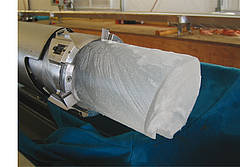European lead in reading past climates from ice cores

Ice core from the EPICA deep drilling (–3264.75 m) at Dome C, Antarctica. (Photo: Laurent Augustin, CNRS/LGGE, Grenoble, France)
Climate change is a reality today, but how can we find out about the future dangers it poses? What we really need is a full record of the Earth’s climate for several hundred thousand years, complete with samples of air from different epochs that can be taken to the lab for analysis. Incredibly, this record exists, in the icecaps of the Arctic and Antarctic regions, and a European Science Foundation programme has a key role in deciphering it.
Professor Thomas Stocker of the University of Bern in Switzerland is one of the principal investigators of EPICA (European Programme for Ice Coring in Antarctica.) Stocker explains that EPICA, a joint ESF- European Commission (EC) effort funded by the Commission and 10 national agencies, has put Europe in a leading position in ice core research, in which specially designed drilling technology is used to obtain continuous ice sequences 3.8 thousands of metres in length.
A series of EPICA papers in prestigious journals such as Nature and Science are evidence of its world importance. The principle behind ice coring is straightforward. Snow falls in Greenland and the Antarctic, but conditions there are too cold for it to melt. In most places it will eventually be carried away by glacial movement, but it is possible to find areas where the snow has piled up for hundreds of thousands of years, turning to ice as the weight of later snowfall builds up on top.
Drilling out a core of such ice reveals the past in a neat sequence of millennia. Better still, the ice contains information about the past. It includes trapped air bubbles that can be analysed to reveal the composition of the ancient atmosphere. Layers of ash reveal ancient volcanic eruptions. And the ratio of different isotopes of oxygen in the ice is a virtual thermometer that tells us past temperatures. The more of the lighter isotope, oxygen 16, there is, the colder it was.
Stocker says: “Ice-drilling is an area in which Europe has taken a decisive technological and scientific lead in the past decade. We now have a continuous record of 800,000 years of climate history, thanks to EPICA and other European initiatives.”
These ice cores directly illuminate current climate debates. As Stocker points out, air bubbles allow us to measure how much methane and carbon dioxide there was in the air when the snow fell. These – especially carbon dioxide – are the principal greenhouse gases in the Earth’s atmosphere. It is clear that they are now at their most abundant for hundreds of thousands of years. By contrast, the most-used direct measurements of atmospheric carbon dioxide, made on Hawaii, only date back to 1958. So as Stocker says: “EPICA results form a cornerstone of the current climate debate.”
EPICA has been responsible for drilling and investigating two deep ice cores in Antarctica. One was at a site called Dome C, and the other at Kohnen research station in Queen Maud Land. At Dome C, ice was drilled out to a depth of 3270m, stopping in December 2004 just 5m above the rocky basement below. Because of the immense pressure at this depth, there is liquid water above the rock, so drilling was stopped to avoid polluting it. At Kohnen station, drilling was completed in January 2006 at a depth of 2774m, where the ice was estimated to be 150,000 years old.
Stocker says that this research is being pushed forward under the umbrella of the current International Polar Year, in which ESF is a contributor. Recently a new project called NEEM (North Greenland Eemian Ice Drilling) has been launched to investigate the Eemian period in Earth history. This warm period from about 130,000 to 115,000 years ago shares similarities with an imminent future greenhouse Earth, and it had sea levels about 7m higher than those we observe today. The NEEM project forms part of IPICS, the International Partnership in Ice Core Sciences. Stocker explains that one of the aims of IPICS is to find the oldest ice in Greenland, probably in the north-west of the island, so that we can get a clear comparison between Arctic and Antarctic narratives of Earth history.
While these cores still have plenty to tell us, Stocker and his colleagues are in little doubt about the overall message. They think that climate “forcing” by greenhouse gases is a very real phenomenon: in other words, that rising greenhouse gas concentrations drive the Earth’s temperature upwards in a very direct way. So the ice cores now deposited in cold “stores” around the world have a clear message for us all.
For more information please go to the www.esf.org/epica
Media contact:
- Professor Thomas StockerE-Mail

